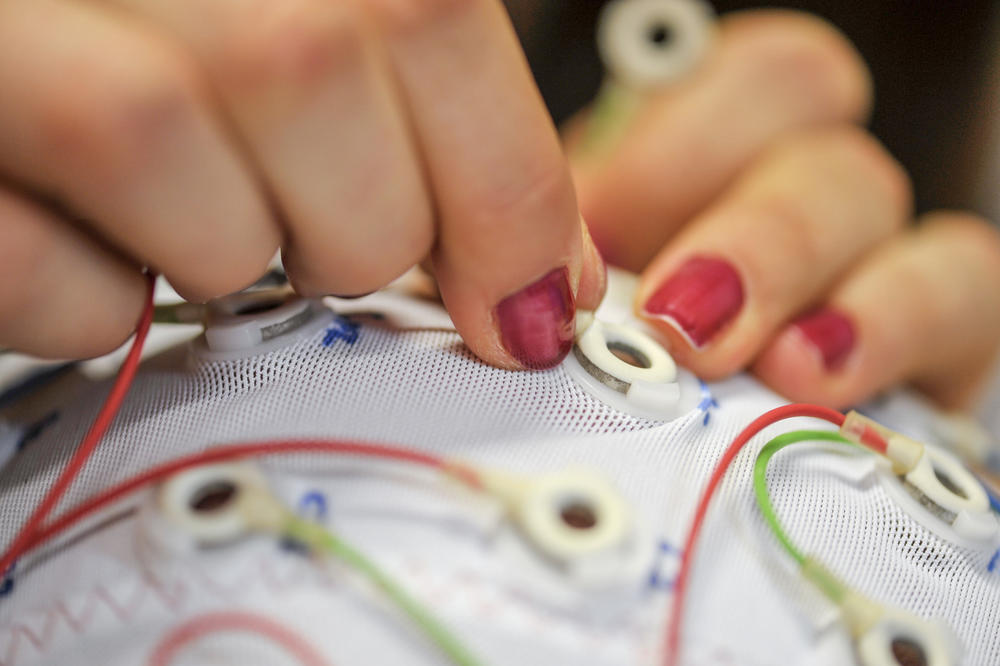EEG as a Window into the Future: Can Machine Learning Help Predict Neurological Problems?
The TrueBrainConnect research project will start in early 2019. Using machine learning algorithms, computer scientist Stefan Haufe wants to analyze EEG data and contribute to doctors being able to detect brain disorders, such as dementia, sooner.
Aug 09, 2018
To be able to recognize brain disorders such as dementia at an earlier stage, scientists such as Stefan Haufe are analyzing data from electroencephalography (EEG).
Image Credit: Bernd Wannenmacher
Chronic diseases do not come out of the blue. Heart attacks usually have a lead time of many years before they occur. Even brain diseases such as dementia or Parkinson’s disease begin long before they manifest clinically. Especially in the case of diseases such as dementia that still cannot be practically treated, it could be of help in identifying people with an increased risk at an early stage, for example, enabling them to take preventative action or prepare their social environment.
As yet, there are not any really good methods for such early detection. In fact, people with an increased risk of dementia can be identified using functional MRI scans. This is, however, too complex and much too expensive to be used as a mass application. Electroencephalography examinations, or EEG in short, i.e., electrical discharges using electrodes on the cranial bone, would be one alternative. These are, however, by no means as easy to interpret as MRI images
Brain diseases begin long before they manifest clinically.
This is where Stefan Haufe comes in. Starting at the beginning of 2019, Haufe will lead the five-year TrueBrainConnect research project, for which three doctoral candidates and a student assistant will be recruited in the second half of the year. Under the European “Horizon 2020” program, the project will be funded by a 1.5 million-euro “starting grant” from the European Research Council (ERC). It is located at the Berlin Center for Advanced Neuroimaging, a joint facility of Charité - Universitätsmedizin Berlin and Humboldt-Universität zu Berlin.
Haufe, with a doctorate in computer science, already studied machine learning as a graduate student at Universität Halle (Saale). This was followed by a doctoral student position at the Machine Learning Group at Technische Universität Berlin and two positions as a research assistant at New York City College and Columbia University in New York. Haufe reports that “EEG data analysis was a major topic at Technische Universität, where, among other things, research is conducted using brain-computer interfaces.” These interfaces are computer systems that are controlled by the brain using thoughts; they are used, for example, in rehabilitation following a stroke. The “mind control” works in many such systems using EEG measurements. Haufe’s work at Technische Universität Berlin and at the universities in New York was highly focused on fundamental research. He says, “At one point, it struck me whether these methods could also be made useful for clinical medicine.”
Stefan Haufe is heading the five-year “TrueBrainConnect” research project.
Image Credit: Wiebke Peitz/Charité
He now wants to try this in the TrueBrainConnect project. Indeed, TrueBrainConnect is to two thirds a methodical project, which means that algorithms and analysis methods are developed, but the clinical aspects distinguish it from other research projects on machine learning. “Another difference is that we want to fix issues in already existing machine learning methods, especially in result interpretation,” says Haufe. The final question is whether the EEG, which which in neurology is currently primarily used to diagnose spasms, could be developed into an easy-to-use, non-invasive, cost-effective screening tool for various brain diseases using machine learning algorithms.
Once the data analysis pipeline is established, the algorithms can be “set free” to clinical EEG data sets.
For this to work, Haufe and his colleagues must first and foremost develop good tools for EEG data analysis with which the machine learning algorithms can work. “We’ve estimated at least the first two project years for this.” In an EEG, electrical signals that are generated when nerve cells transmit information are measured. As a non-invasive method from “outside the body,” the EEG is not able to provide information on individual cells or cell groups, but only generates signals in which different processes in the brain overlap, thus making the analysis of these electrical signals very complex. Subsequently, one of the topics to be addressed during the projects’ first years is the question how, using noticeable EEG signals, the region in the brain where the noticeable activity originates can be best located.
Once the data analysis pipeline is established, the algorithms can be “set free” to clinical EEG data sets. For this purpose, Haufe is in contact with several neurologists who have corresponding EEG databases at their disposal. In cooperation with clinical partners from Charité - Universitätsmedizin Berlin, the researchers hope to gain a better understanding of how the information flows between the deep brain structures and the cortex in people suffering from Parkinson’s disease, as it is known that problems occur somewhere at this interface. In the distant future, the EEG and machine learning algorithms might even be used to predict trips and falls in Parkinson patients. Progress forecasts for dementia patients is another clinical application.
The development of the algorithms is strongly dependent on the available data, which can be used to train the algorithms.
As always with machine learning, the development of algorithms depends on the available data that can be used to train the algorithms. “Unfortunately, there are currently no really convincing data records for the EEG,” Haufe emphasizes. When it comes to structural and functional magnetic resonance imaging, the prerequisites are much better: “We have high hopes for public databases which are currently being established.”
Longitudinal data sets, i.e., data from people for whom EEGs were produced at different times in their lives and some of whom develop neurological diseases whereas others do not, are of particular importance. Then the machine learning algorithms could be used to try to predict the different processes. It is difficult to estimate how many patients are needed to train the algorithms reliably enough. “I would consider a sample size of 500 to be ideal,” says Haufe, but in practice even small numbers of test persons could already provide valuable information.


